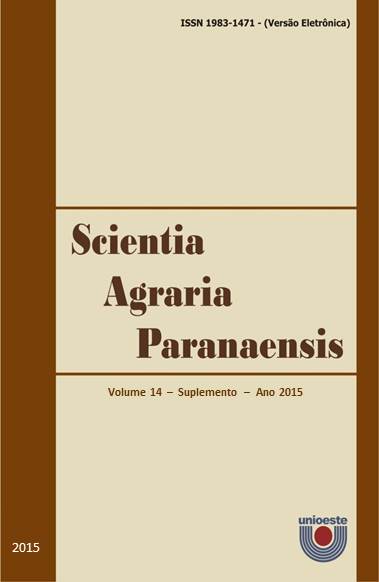Embalagens na proteção contra pragas de frutos de caquizeiro
DOI:
https://doi.org/10.18188/sap.v14i0.11748Palavras-chave:
caqui, cochonilha, mosca-da-fruta.Resumo
A cultura do caquizeiro pode ser atacada por várias pragas e doenças, no entanto, existem poucos trabalhos relacionados ao controle. Além disso, existe uma carência de agrotóxicos registrados no Ministério da Agricultura, Pecuária e Abastecimento (MAPA), surgindo o ensacamento de frutos como alternativa. O objetivo do trabalho foi avaliar diferentes embalagens protetoras para ensacamento de frutos de caqui visando o controle de pragas e doenças e, consequentemente, a melhoria da qualidade dos frutos. O experimento foi conduzido em um pomar de caquizeiros da estação experimental do Instituto Federal de Educação, Ciência e Tecnologia do Rio Grande do Sul, localizada no Distrito de Tuyuti, em Bento Gonçalves, RS. Foram realizados quatro tratamentos: testemunha (frutos não ensacados), ensacamento utilizando embalagem de polipropileno perfurado, embalagem de TNT (tecido-não-texturizado) de coloração branca e embalagem de papel kraft pardo. Os frutos colhidos foram avaliados quanto a massa média, sintomas de danos de lagartas, presença de cochonilhas-brancas Pseudococcus sp. e sintomas de sujeira-de-mosca (Schyzothyrium pomi). A flutuação populacional de Anastrepha fraterculus foi realizada utilizando armadilha McPhail com proteína hidrolisada. Entre os tratamentos, somente os frutos protegidos com polipropileno perfurado diferiram estatisticamente da testemunha nas avaliações de massa média e incidência de sujeira-de-mosca. No entanto, não apresentaram diferença significativa para os danos produzidos por lagartas e a ocorrência de cochonilhas-brancas. A utilização de polipropileno perfurado demonstrou eficiência no controle da sujeira-da-mosca podendo ser empregada para diminuir os danos ocasionados nos frutos.
Downloads
Publicado
Como Citar
Edição
Seção
Licença
Aviso de Direito Autoral Creative Commons
Política para Periódicos de Acesso Livre
Autores que publicam nesta revista concordam com os seguintes termos:
1. Autores mantém os direitos autorais e concedem à revista o direito de primeira publicação, com o trabalho simultaneamente licenciado sob a Licença Creative Commons Attribution que permite o compartilhamento do trabalho com reconhecimento da autoria e publicação inicial nesta revista.2. Autores têm autorização para assumir contratos adicionais separadamente, para distribuição não-exclusiva da versão do trabalho publicada nesta revista (ex.: publicar em repositório institucional ou como capítulo de livro), com reconhecimento de autoria e publicação inicial nesta revista.
3. Autores têm permissão e são estimulados a publicar e distribuir seu trabalho online (ex.: em repositórios institucionais ou na sua página pessoal) a qualquer ponto antes ou durante o processo editorial, já que isso pode gerar alterações produtivas, bem como aumentar o impacto e a citação do trabalho publicado (Veja O Efeito do Acesso Livre).
Licença Creative Commons
Esta obra está licenciada com uma Licença Creative Commons Atribuição-NãoComercial-CompartilhaIgual 4.0 Internacional, o que permite compartilhar, copiar, distribuir, exibir, reproduzir, a totalidade ou partes desde que não tenha objetivo comercial e sejam citados os autores e a fonte.


